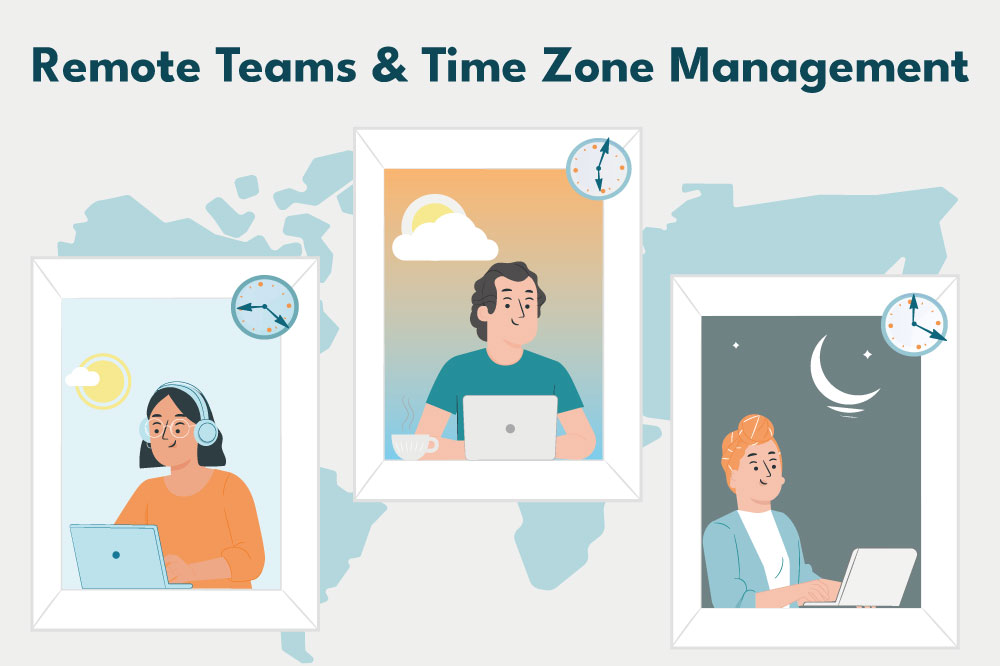Remote teams & Time Zone Management
Building remote teams has become the new normal, especially in the post-pandemic era. Remote teams have become a near-infinite reservoir of talents. It helps businesses enjoy the diversity that comes with building a team from all walks of life, from different cultures, experiences, educational backgrounds and expertise. With the advances in technology, teams have been able to collaborate seamlessly with each other. But there is one challenge that surpasses technology; time zone differences.
A business based on a certain time zone may have clients and remote teams operating in an entirely different time zone. The remote team itself may comprise team members from different time zones. So in order to have a meeting or discussion, three to four time zones have to be kept in mind. If team members are more than 8 hours apart, a part of the team may work during normal business hours. But others would have to work night shifts regularly.

So how to ease the pain of remote teams working with time zone differences?
1. Challenges faced due to time zone differences
When clients and team members are distributed across the globe, businesses have to deal with quite a number of problems due to time zone differences. Common challenges would be setting appointments with clients or planning a demo. There may be requirement clarification issues among the team members and clients. When the time difference exceeds eight hours, misunderstandings can be clarified only when the client is available probably the next day. This leads to a lot of rework which may subsequently increase the project cost and reduce client satisfaction a great deal. There are communication challenges too where the client and team members find it hard to hold meetings at a time comfortable for both.
2. Understanding time differences
A time zone is a region where the same standard time is followed. This region varies between states and countries. A time offset is the time difference of a particular region from the standard reference time, also known as UTC (Coordinated Universal Time). It represents the time ahead or behind the reference time, for example. GMT+4.00 or GMT-5.00. So before building and managing a remote team, you should be aware of the time differences between you, the client and each team member. This is important for seamless communication and work collaboration. In addition to this, keep a check on which parts of the world are currently observing the DST. Daylight Saving Time (DST) is the practice followed by certain regions to put natural daylight to better use. With DST, clocks are set forward one hour from standard time during the summer months and are set back again in the fall.
3. Make use of tools and technology
To deal with the time differences, there exists a number of online tools that would make the team’s job easier. The team must be given a common work space, where they can view, share, and collaborate on the information they need. Applications like Google Drive, Wiki and Google documents make it possible to share and edit documents, projects and other files. The commenting feature in Google Docs helps multiple people share their views on a single file without having to wait for other team members to be online. This gives a lot of time flexibility. There are various tools and apps to manage time that help calculate time zone differences taking into account Daylight Saving Time (DST). Google Calendar allows scheduling meetings and appointments in different time zones required. So we don’t need to worry about time conversions. Make use of online time difference calculators and meeting planners to create schedules and meetings at the comfort of all team members. Another way is to record live meetings. So even if a few members are unable to attend the meeting, no one misses out on any detail of the ongoing project.
4.Be mindful of remote team members while scheduling meetings
See if a meeting is really necessary. You can have a discussion or take questions asynchronously by email or using applications like Teams and Slack. Schedule meetings only if important decisions are to be made or discussions are really necessary. Online collaboration tools like Miro, Jamboard, Teams, Slack can be used to finish part of the work before the meeting starts to save time. This will help people from different time zones to spend their time outside their business hours put to good use. Avoid involving all the members of the team attending all the meetings. Instead, decide on the key members who need to be involved in the meeting. Different people may have different work styles and different productive times. Some people may find themselves more productive during the night but some may be more active during the early morning hours. When your team members are from different time zones, try finding out their comfortable time. Hold meetings at a time that is suitable for most of the team members.
Holding meetings at the same time regularly might be uncomfortable for team members from a particular time zone. This may require a certain set of people waking up at early hours regularly. So having a rotation in meeting times can reduce the pain of the team members.
5. Take advantage of the time gap by extending a few hours in work schedules
The timezone gap can even be converted into an advantage. The clients may discuss their requirements in the evening and can see the results when they reach the office the next morning. Businesses can find ways to handle offshore teams by extending a few hours after dinner time. A couple of hours is all that’s needed for small discussions, meetings, brainstorming and decision-making. The overlapping time gaps can be used for holding meetings and discussions on work progress involving all the remote team members. You can turn this time gap to your advantage. Your remote team that shares the same time zone with your client, may provide assistance even if you clock out.
6. Report Work status in detail
In remote teams, it is possible that the team manager and the team members may belong to different time zones. The manager may be having a tough time monitoring the work of each team member. So proper documentation and reporting of work status must be done on a daily basis. This would really help evaluate whether the work is going in the right direction. This would save the team from unwanted rework being done due to misunderstanding the requirements of clients.
7. Recruit regional team leads
For managers to remotely monitor team members might be a challenge. Instead, recruiting a region-specific manager would solve many issues. Firstly, a person belonging to the same zones as the members might have a good idea about their cultural values. That would bring better coordination among the team members that will eventually increase their productivity. Secondly, if you are monitoring people in different time zones, you’ll have to wait for a common time to communicate. On the contrary, if they are from the same time zone, it is easier to have time to time discussions with team members and rectify ambiguities if any.
8. Follow Hybrid approach
Remote teams have more flexibility and cost-effectiveness as compared to the native workforce. However, the difference in time zones of more than 8 hours is a real challenge when ambiguities are to be rectified during office hours. This is where Hybrids come in handy. When companies are registered in the same time zones as their team’s location and their client’s location, they are called Hybrids. This becomes easier for companies to manage their offshore teams during the same working hours.
Final Thoughts
Building remote teams can be very productive and cost-effective for businesses. But dealing with the time zone differences may be a challenge where team communication and collaboration can cause concerns. By understanding the differences between the team members and practicing empathy, managers and leads can easily manage the workflow across the teams.
Centizen
A Leading IT Staffing, Custom Software and SaaS Product Development company founded in 2003. We offer a wide range of scalable, innovative IT Staffing and Software Development Solutions.
Contact Us
USA: +1 (971) 420-1700
Canada: +1 (971) 420-1700
India: +91 63807-80156
Email: contact@centizen.com
Our Services
Products
Contact Us
USA: +1 (971) 420-1700
Canada: +1 (971) 420-1700
India: +91 63807-80156
Email: contact@centizen.com






